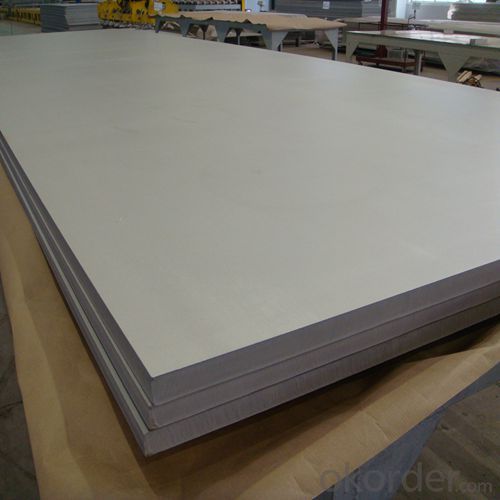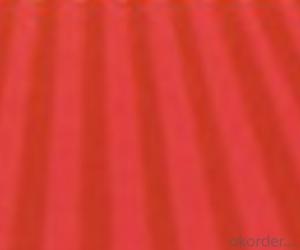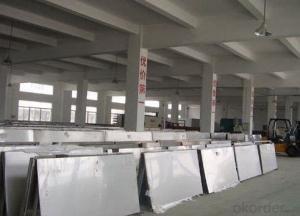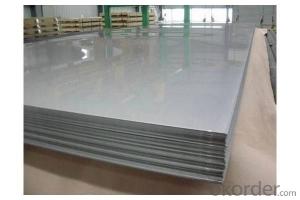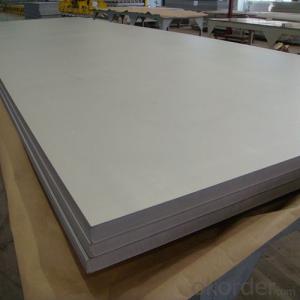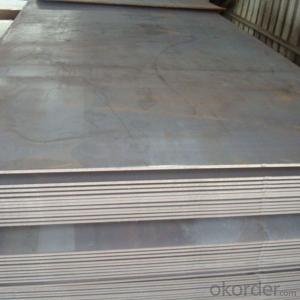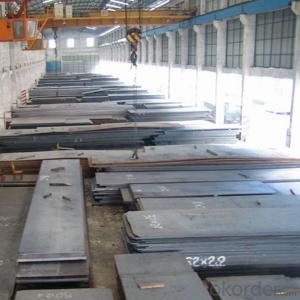Carbon Steel Plate China Structural Steel Plate High Quality Good Price
- Loading Port:
- Shanghai
- Payment Terms:
- TT or LC
- Min Order Qty:
- 1000 m.t.
- Supply Capability:
- 60000 m.t./month
OKorder Service Pledge
OKorder Financial Service
You Might Also Like
Product Description:
OKorder is offering Carbon Steel Plate China Structural Steel Plate High Quality Good Price at great prices with worldwide shipping. Our supplier is a world-class manufacturer of steel, with our products utilized the world over. OKorder annually supplies products to European, North American and Asian markets. We provide quotations within 24 hours of receiving an inquiry and guarantee competitive prices.
Product Applications:
Carbon Steel Plate China Structural Steel Plate High Quality Good Price are ideal for structural applications and are widely used in the construction of buildings and bridges, and the manufacturing, petrochemical, and transportation industries.
Product Advantages:
OKorder's Carbon Steel Plate China Structural Steel Plate High Quality Good Price are durable, strong, and resist corrosion.
Main Product Features:
· Premium quality
· Prompt delivery & seaworthy packing (30 days after receiving deposit)
· Corrosion resistance
· Can be recycled and reused
· Mill test certification
· Professional Service
· Competitive pricing
Product Specifications:
Introduction
Ordinary carbon structural steel and ordinary carbon steel. The carboncontent of less than 0.25% 0.06-0.22%, the most commonly used. Belongs to the low carbon steel, in each metal steel grades, minimum yield point thickness is less than 16mm. Compared with high-quality carbon structural steel, carbon content, performance and phosphorus, sulfur and other residual element content range. Provide security conditions in the China and some countries,ordinary carbon steel is divided into three categories: Steel (Xing Gang), only to ensure that the mechanical properties, does not guarantee the chemical composition, type B steel (B steel), only to ensure that the chemical composition, does not guarantee the special mechanical properties; steel(steel). Not only guarantee the chemical composition and mechanical properties, guarantee. Manufacturing structural components often used in special steel is very important..
Component is mainly used for the production of carbon structure steel structure engineering. It is commonly used to supply conditions, high sulfur,phosphorus content in steel, allows up to 0.050% and 0.045% respectively.Steel accounted for a larger proportion, total output in this steel.
3 application of this kind of steel from oxygen converter, open hearth furnaceor electric furnacesmelting, hot rolled steel, steel strip, the general part and bar. Plate usually volume (including control rolling) or normalizing treatment delivery. The chemical composition of the steel, mechanical properties, andbendingperformance shall comply with the relevant provisions.
In the Chinese national standard GB700-88 steel according to yield values are divided into 5 grades, and by mass is divided into 4 level. With the letter Qsymbol level, yield, yield value, quality rating symbol, consisting of 4 parts of the deoxidation method according to the order of.
The scope of application of this kind of steel is very extensive, mainly used for welding, riveting or steel structural bolts, minority is producing all kinds of machinery parts. Q195, and low strength of Q215 steel, the production of low carbon steel wire. Stainless steel wire mesh, the roof plate, welded steel pipe,anchor bolts and rivets etc.. Q235 steel of moderate intensity, and has good plasticity and toughness, easy forming and welding. This steel usually used for reinforcing steel structure, also used as a rivet, a railroad spike and variousmechanical parts, such as bolts, connecting rod, connecting rod. 255, Q275 high strength steel used in agricultural machinery production, can also be used as reinforcement of railway fishplate.
According to the special requirements for steel performance in some industries, for ordinary carbon structural steel composition adjustment and a series of professional steel after forming, such as cold heading steel, bridge steel, pressure vessel steel, steel, steel for boiler. In addition to the chemical composition of the strict control of steel used, so that the performance of the conventional, but also provides some special inspection of the project, such as low temperature impact toughness, aging sensitivity, gas in steel, inclusions and fracture etc..
Overview of Q235A features and scope of applications: Q235A toughness and the plasticity is good, have certain elongation, has good welding properties and hot workability. Q235A is generally used in hot rolling state, with steel, the rolling steel, steel plate, steel pipe can be used for welded structures, bridges and generally not important machine parts manufacturing all kinds of, such as bolts, rivets, rings and connecting rod, etc..
Said method: the symbolic quality rating symbol + deoxidation method of Q+ digital + composition. Its steel dubbed "Q", representing the yield point of steel, behind the figures to show that the yield point value units are MPa Q235 says such yield point (s) of carbon structural steel, 235 MPa. The necessary grades can be followed Mark said quality grade and deoxidizing method symbol. Quality level symbols are for A, B, C, D. Deoxidation method symbol: F said rimming steel;
B said semi killed steel: Z said calm steel; TZ said special calm steel, steel standard symbols not calm, namely Z and TZ are not standard. For example, Q235-AF said a rimmed steel. Carbon steel specially uses, such as for bridge steel.
FAQ:
Q1: Why buy Materials & Equipment from OKorder.com?
A1: All products offered byOKorder.com are carefully selected from China's most reliable manufacturing enterprises. Through its ISO certifications, OKorder.com adheres to the highest standards and a commitment to supply chain safety and customer satisfaction.
Q2: How do we guarantee the quality of our products?
A2: We have established an advanced quality management system which conducts strict quality tests at every step, from raw materials to the final product. At the same time, we provide extensive follow-up service assurances as required.
Q3: How soon can we receive the product after purchase?
A3: Within three days of placing an order, we will begin production. The specific shipping date is dependent upon international and government factors, but is typically 7 to 10 workdays.
Q4: What makes stainless steel stainless?
A4: Stainless steel must contain at least 10.5 % chromium. It is this element that reacts with the oxygen in the air to form a complex chrome-oxide surface layer that is invisible but strong enough to prevent further oxygen from "staining" (rusting) the surface. Higher levels of chromium and the addition of other alloying elements such as nickel and molybdenum enhance this surface layer and improve the corrosion resistance of the stainless material.
Q5: Can stainless steel rust?
A5: Stainless does not "rust" as you think of regular steel rusting with a red oxide on the surface that flakes off. If you see red rust it is probably due to some iron particles that have contaminated the surface of the stainless steel and it is these iron particles that are rusting. Look at the source of the rusting and see if you can remove it from the surface.
Images:
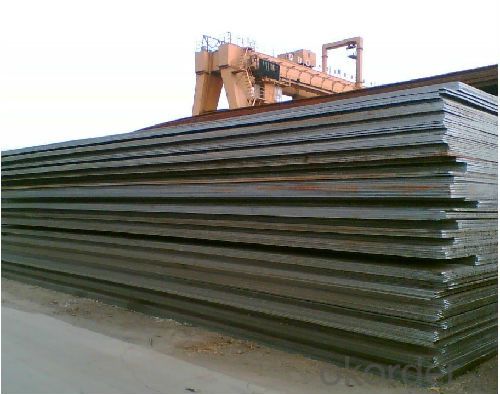

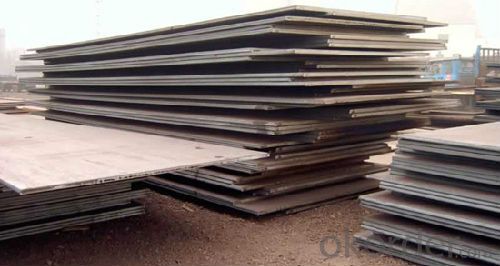
- Q: Can steel sheets be used for cladding?
- Yes, steel sheets can be used for cladding.
- Q: Can the steel sheets be used for outdoor furniture?
- Outdoor furniture can indeed utilize steel sheets. Steel, being a robust and weather-resistant substance, is well-suited for outdoor purposes. It can withstand diverse environmental conditions, including rain, wind, and sunlight, without rapid corrosion or deterioration. Moreover, steel sheets can be manipulated and formed into various furniture styles, offering both practicality and visual allure. Whether it's tables, chairs, benches, or even decorative accents, steel sheets prove to be an exceptional option for outdoor furniture due to their durability, longevity, and adaptability.
- Q: Can steel sheets be used for signage or advertising displays?
- Yes, steel sheets can be used for signage or advertising displays. Steel is a durable and versatile material that can be shaped, cut, and painted to create attractive and long-lasting signs and displays. Additionally, steel sheets can withstand outdoor conditions, making them suitable for both indoor and outdoor advertising purposes.
- Q: What is the maximum width of steel sheets?
- The maximum width of steel sheets can vary depending on the specific type and grade of steel, but it typically ranges from 72 inches to 96 inches.
- Q: Can steel sheets be bent without causing damage?
- Yes, steel sheets can be bent without causing damage, provided that the bending process is done carefully and within the limits of the material's properties. Steel sheets are commonly bent using various techniques such as press brake bending or roll bending. These processes involve applying controlled force and pressure to the sheet to achieve the desired shape without causing any permanent deformation or damage. The ability to bend steel sheets without damage depends on several factors, including the thickness and grade of the steel, the bending radius, and the equipment and technique used. Thinner sheets are generally more flexible and easier to bend, while thicker sheets may require higher forces and specialized equipment. It is essential to consider the steel's tensile strength, yield strength, and elongation properties to ensure that the bending process does not exceed its limits. Excessive bending can lead to cracks, fractures, or permanent deformations, compromising the sheet's structural integrity. To prevent damage during bending, it is crucial to follow proper bending techniques and guidelines. This includes using appropriate tooling, ensuring even distribution of force, and avoiding sharp changes in direction or excessive bending angles. Additionally, preheating the steel sheet can make it more pliable and reduce the risk of damage. In summary, steel sheets can be bent without causing damage, but it requires careful consideration of the material's properties, proper equipment, and adherence to bending guidelines. By employing the right techniques and precautions, steel sheets can be successfully bent into various shapes and forms while maintaining their structural integrity.
- Q: Are steel sheets suitable for electrical grounding applications?
- Indeed, electrical grounding applications can find steel sheets to be fitting. As a proficient conductor of electricity, steel can proficiently transmit electrical charges to the ground. Due to their endurance, robustness, and cost-efficiency, steel sheets are frequently employed in grounding applications. Their installation is simple, and they offer a trustworthy link to the earth, guaranteeing a secure pathway for electrical currents in the event of a fault or surge. Nevertheless, it is imperative to ensure the proper installation and upkeep of steel sheets, as any corrosion or harm can impede their conductivity and hinder their efficacy in grounding electrical systems.
- Q: How do steel sheets compare to aluminum sheets in terms of weight?
- Steel sheets are generally heavier than aluminum sheets.
- Q: Can steel sheets be etched or engraved?
- Yes, steel sheets can be etched or engraved using various techniques such as chemical etching, laser engraving, or mechanical engraving.
- Q: How are steel sheets protected against rusting?
- Steel sheets are protected against rusting through a process called corrosion protection. There are several methods used to protect steel sheets from rust, including: 1. Galvanization: This process involves coating the steel sheets with a layer of zinc. Zinc acts as a sacrificial anode, meaning it corrodes in place of the steel when exposed to moisture or oxygen. This creates a barrier that protects the steel from rusting. 2. Painting: Applying a layer of paint to steel sheets acts as a protective barrier against moisture and oxygen. The paint creates a physical barrier that prevents these elements from coming into contact with the steel, thus reducing the risk of rust formation. 3. Powder coating: Powder coating involves applying a dry powder to the steel sheets and then heating it to form a protective layer. The powder melts and fuses into a smooth coating, providing excellent resistance to rust and corrosion. 4. Electroplating: This method involves immersing the steel sheets in a bath containing a metal coating solution, such as zinc or chromium. An electric current is then passed through the bath, causing the metal coating to bond with the steel. This electroplated layer acts as a protective barrier against rust. 5. Phosphating: Phosphating is a chemical process where a layer of zinc or manganese phosphate is deposited on the steel sheets. This layer enhances the adhesion of paint or other coatings, providing a corrosion-resistant surface. These methods are commonly used in various industries to protect steel sheets from rusting. The specific method chosen depends on factors such as cost, durability requirements, and the environment in which the steel sheets will be used.
- Q: Can steel sheets be used for fire-rated doors?
- Yes, steel sheets can be used for fire-rated doors. In fact, steel is one of the most commonly used materials for fire-rated doors due to its high strength, durability, and fire-resistance properties. Steel sheets used in fire-rated doors are typically constructed with multiple layers of fire-resistant material, such as gypsum or mineral core, sandwiched between the steel sheets. This construction helps to prevent the spread of fire and smoke, providing a reliable barrier in the event of a fire. Additionally, steel is known for its structural integrity, making it a suitable choice for fire-rated doors that need to withstand high temperatures and pressure.
Send your message to us
Carbon Steel Plate China Structural Steel Plate High Quality Good Price
- Loading Port:
- Shanghai
- Payment Terms:
- TT or LC
- Min Order Qty:
- 1000 m.t.
- Supply Capability:
- 60000 m.t./month
OKorder Service Pledge
OKorder Financial Service
Similar products
Hot products
Hot Searches
Related keywords



